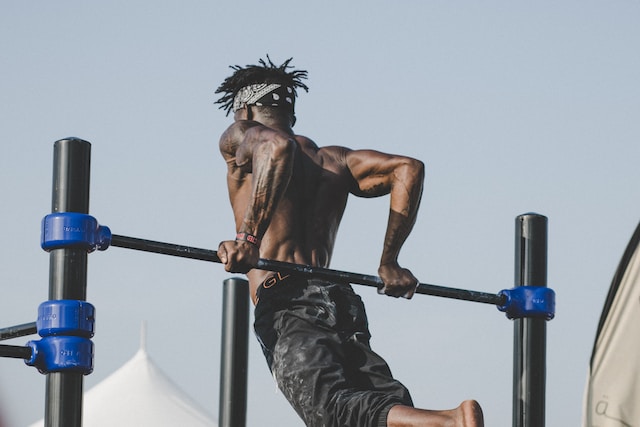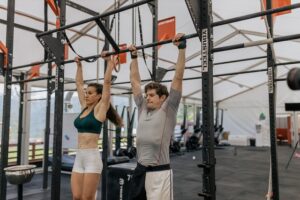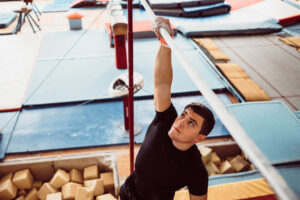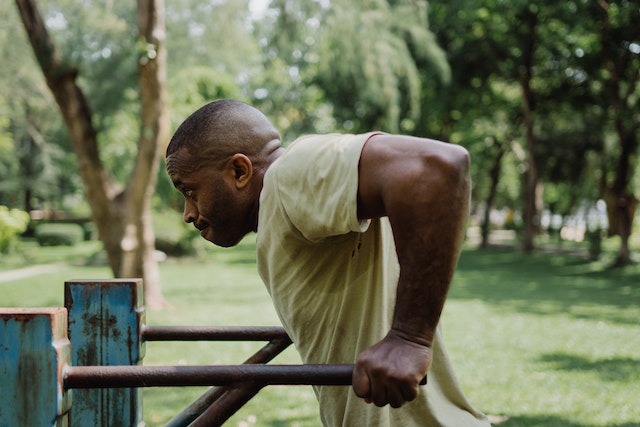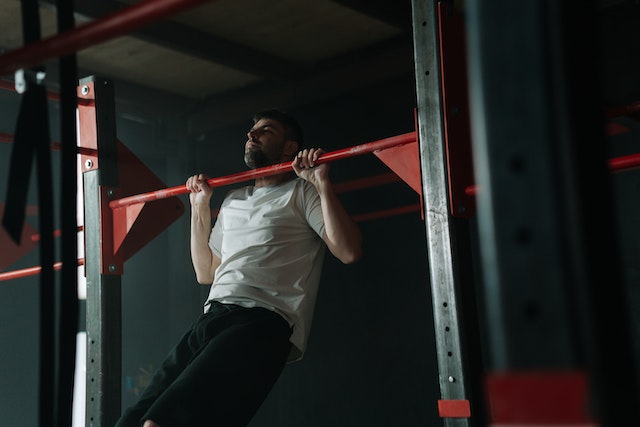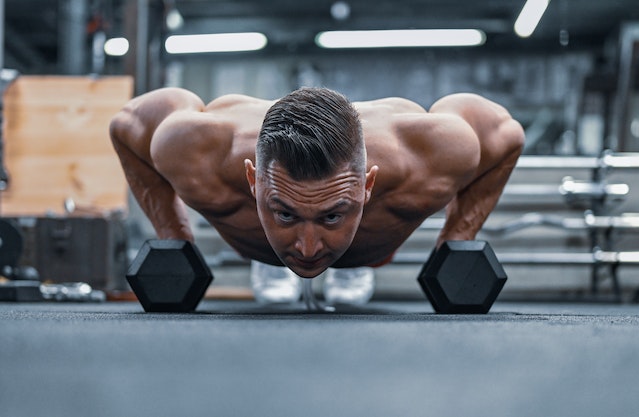Are you ready to take your calisthenics routine to the next level with a thrilling and challenging exercise? Look no further than Korean Dips. This dynamic and exhilarating movement will not only sculpt your upper body but also push your limits and unlock your true strength. In this guide, we’ll delve into the world of Korean Dips, exploring their unique benefits and providing you with a step-by-step roadmap to mastering this impressive calisthenics exercise. Whether you’re a fitness enthusiast looking for a new challenge or a calisthenics pro seeking to enhance your skills, Korean Dips will undoubtedly leave you feeling accomplished and empowered. So, get ready to elevate your training and discover the captivating world of Korean Dips. Let’s dive in!
Understanding Korean Dips
Korean Dips are an advanced calisthenics exercise that will take your upper body strength and muscular development to new heights. Unlike traditional dips, Korean Dips offer a unique twist by incorporating a lower transition phase, which engages additional muscle groups and challenges your stability.
These dips primarily target the chest, triceps, and shoulders, making them a fantastic exercise for building strength and size in your upper body. By mastering Korean Dips, you’ll not only enhance your pushing power but also develop impressive muscular definition and functional strength.
What sets Korean Dips apart from regular dips is the lower transition phase. During this phase, you’ll dip your body down until your forearms are parallel to the ground, creating a deeper range of motion. This extended range challenges your triceps and shoulders in a whole new way, activating more muscle fibers and fostering greater growth and strength gains.
Moreover, Korean Dips improve your stability and body control as you navigate through the transition phase. By engaging your core muscles and focusing on proper form, you’ll develop a solid foundation for other advanced calisthenics movements.
Whether you’re an experienced athlete or a beginner looking for a new challenge, understanding the mechanics and benefits of Korean Dips is essential. So, let’s dive deeper into the step-by-step guide on how to perform this exhilarating exercise and unlock your full potential.
Preparing for Korean Dips
Before diving into the thrilling world of Korean Dips, it’s crucial to properly prepare your body for the challenge ahead. A thorough warm-up routine is essential to activate the muscles and increase blood flow, reducing the risk of injury and maximizing performance. Here are some key steps to get your body primed for Korean Dips:
- Warm-up with dynamic stretches: Begin with light cardiovascular activity like jogging or jumping jacks to get your blood flowing. Follow it up with dynamic stretches that target the muscles involved in Korean Dips, such as arm circles, shoulder rolls, and wrist rotations. This will loosen up your joints and increase mobility.
- Activate the upper body muscles: Perform a series of exercises to activate and engage the muscles you’ll be using during Korean Dips. Push-ups, chest flies, and triceps dips are great choices to activate the chest, triceps, and shoulders. Focus on quality repetitions rather than quantity, ensuring proper form and muscle activation.
- Incorporate shoulder mobility exercises: Korean Dips require a good range of motion in the shoulders. Include exercises like shoulder dislocations with a resistance band or shoulder circles to improve mobility and flexibility in the shoulder joint.
- Practice proper form and posture: Before attempting Korean Dips, familiarize yourself with correct form and posture. Maintain a tall posture with your chest lifted and shoulders back. Engage your core muscles to stabilize your body throughout the exercise. This foundation will help you execute the dips safely and effectively.
By taking the time to adequately warm up and prepare your body, you’ll set yourself up for success in mastering Korean Dips. So, let’s move on to the exciting part—learning the step-by-step technique to perform Korean Dips like a pro.
Step-by-Step Guide to Korean Dips
Get ready to conquer the world of Korean Dips with this comprehensive step-by-step guide. Mastering the proper technique will not only ensure optimal muscle engagement but also help you build strength and achieve impressive results. Let’s dive into the intricacies of performing Korean Dips:
- Find the right equipment: Locate straight bar that can support your body weight. Ensure that the bar stable and at a comfortable height.
- Begin in the starting position: Stand in fornt of the bar and grip it firmly with an overhand grip with your elbows back. Your palms should face downward, and your hands should be shoulder-width apart. Keep your arms fully extended, and your feet slightly off the ground.
- Lower your body: Initiate the movement by bending your elbows and lowering your body down. Focus on maintaining control throughout the descent. Keep your chest up, and allow your elbows to flare out slightly.
- Reach the lower transition phase: Continue lowering your body until your forearms are parallel to the ground. This lower position is what distinguishes Korean Dips from regular dips, providing an increased challenge and muscle activation.
- Transition upwards: Once you reach the lower transition phase, engage your core muscles and initiate the ascent. Push through your hands and drive your body upward, extending your elbows and returning to the starting position.
- Maintain proper form: Throughout the movement, keep your body aligned and avoid swinging or excessive momentum. Control the motion both on the way down and up, focusing on engaging the targeted muscles—chest, triceps, and shoulders.
- Breathe effectively: Inhale as you lower your body, and exhale as you push back up. This controlled breathing pattern helps stabilize your core and maintain focus during the exercise.
- Gradually increase difficulty: As you become more comfortable with the movement, challenge yourself by adding additional resistance using a weighted vest or dipping belt. You can also experiment with different hand positions or tempo variations to intensify the exercise.
Remember, consistency and proper form are key when performing Korean Dips. It’s better to start with easier progressions and gradually work your way up to the full movement, ensuring safety and progress. Stay dedicated, push your limits, and soon you’ll be executing Korean Dips with strength and finesse.
Now that you have the foundation, let’s explore ways to progress and unleash your true potential with advanced variations of Korean Dips.
Supplementary Exercises
To complement your Korean Dips and optimize your overall calisthenics training, incorporating supplementary exercises is key. These exercises target additional muscle groups and contribute to a well-rounded and balanced physique. Here are some essential supplementary exercises to consider:
- Core Strengthening: A strong core is crucial for stability and control during Korean Dips. Include exercises like planks, L-sits, and hanging leg raises in your routine. These movements will engage your abdominal muscles, obliques, and hip flexors, providing a solid foundation for your calisthenics endeavors.
- Upper Body Strength Builders: Enhance your upper body strength with exercises like push-ups, pull-ups, and handstands. Push-ups target the chest, triceps, and shoulders, while pull-ups engage the back and biceps. Handstands not only strengthen your shoulders but also improve balance and body awareness.
- Dips Variations: Besides Korean Dips, explore different dip variations such as ring dips or weighted dips. These variations challenge your muscles in different planes of motion, further stimulating growth and strength development.
- Mobility and Flexibility: Dedicate time to improve your overall mobility and flexibility. Incorporate exercises like shoulder dislocations, thoracic spine rotations, and hip stretches to enhance the range of motion in your joints. Improved mobility will not only optimize your performance in Korean Dips but also reduce the risk of injuries.
- Grip Strength Training: Develop a powerful grip, as it plays a crucial role in maintaining stability during Korean Dips. Utilize grip strengtheners, farmer’s carries, or hanging exercises to target your forearm muscles and improve your grip strength.
By incorporating these supplementary exercises into your training routine, you’ll strengthen supporting muscle groups, improve overall body control, and enhance your performance in Korean Dips. Remember, variety is key to continuously challenging your body and avoiding stagnation. So, don’t be afraid to experiment and mix up your workouts.
Now that we’ve covered supplementary exercises, let’s address common mistakes and troubleshooting tips to ensure you’re getting the most out of your Korean Dips experience.
Common Mistakes and Troubleshooting
While performing Korean Dips, it’s important to be aware of common mistakes that can hinder your progress or increase the risk of injury. By identifying and addressing these issues, you can optimize your technique and make the most of your calisthenics journey. Here are some common mistakes to watch out for and troubleshooting tips to help you overcome them:
Improper Form
One of the most common mistakes is sacrificing form for quantity. Avoid hunching your shoulders or arching your back during the movement. Maintain a tall posture with your chest up, shoulders back, and core engaged throughout the exercise.
Troubleshooting Tip: Focus on quality over quantity. Perform the exercise with controlled movements, ensuring proper alignment and muscle engagement. If necessary, reduce the number of repetitions to maintain correct form.
Insufficient Range of Motion
Failing to reach the lower transition phase can limit the effectiveness of the exercise. Not going deep enough robs you of the full benefits and muscle activation that Korean Dips offer.
Troubleshooting Tip: Work on improving your mobility and flexibility to achieve a deeper range of motion. Gradually increase your depth, ensuring proper control and stability throughout the movement. Remember, quality reps with a full range of motion are more important than quantity.
Lack of Core Engagement
Neglecting to engage your core muscles can lead to instability and poor body control during Korean Dips. Your core plays a crucial role in maintaining proper form and stability throughout the exercise.
Troubleshooting Tip: Prioritize core engagement by actively contracting your abdominal muscles throughout the entire movement. Imagine pulling your belly button towards your spine to activate your core and maintain stability.
Overreliance on Momentum
Swinging or using excessive momentum to execute the movement diminishes the effectiveness of Korean Dips. It reduces the tension on the targeted muscles and increases the risk of injury.
Troubleshooting Tip: Focus on performing slow and controlled repetitions. Emphasize the eccentric (lowering) phase and maintain control as you push back up. Avoid any swinging or bouncing motions, ensuring that each rep is performed under your own power.
Neglecting Rest and Recovery
Giving your body adequate time to recover is crucial for progress and injury prevention. Overtraining without proper rest can lead to decreased performance and increased risk of overuse injuries.
Troubleshooting Tip: Allow for sufficient rest between training sessions. Incorporate rest days into your routine to give your muscles time to repair and grow stronger. Listen to your body and adjust your training volume and intensity accordingly.
By being mindful of these common mistakes and implementing the troubleshooting tips, you’ll optimize your performance, reduce the risk of injury, and achieve the best results from your Korean Dips. Now, let’s explore a training program to help you integrate Korean Dips into your regular routine.
Final Thoughts
Mastering Korean Dips in calisthenics is a gateway to unlocking incredible upper body strength and muscle development. Embrace the challenges, stay consistent, and persevere on your journey. Let the electrifying world of Korean Dips inspire you to push your limits and achieve greatness. Your calisthenics adventure starts now. Soar, achieve, and redefine your limits. The world of calisthenics awaits you!
